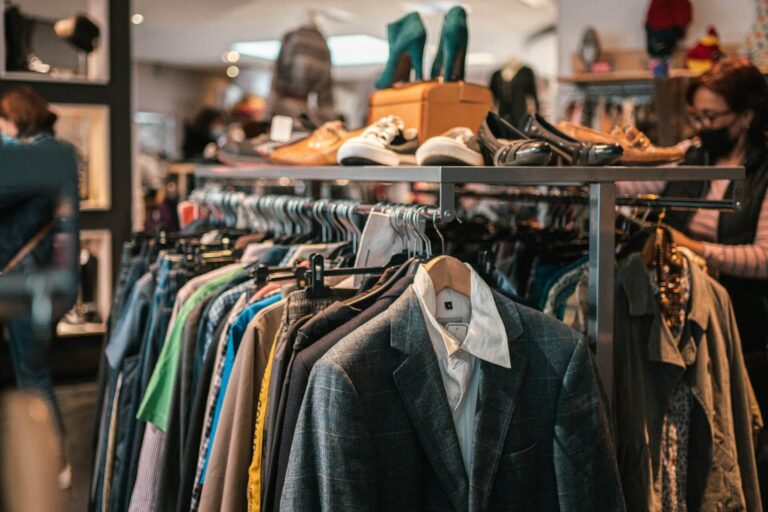In a world replete with fast fashion, the environmental and ethical implications of our clothing choices have never been more pressing.
Thrifting and upcycling are more than just buzzwords; they represent a conscious shift towards sustainable living and a creative approach to our wardrobes.
Discovering the art of thrift shopping and upcycling is not only invigorating but also profoundly impactful on our planet and personal style.
In this comprehensive guide, we will explore how these practices can redefine your fashion sense and contribute towards a greener future.
The Thrifting Movement: A Brief History
Thrift shopping has a rich history dating back to the end of the 19th century when charitable organizations in Europe and North America began selling second-hand clothes to raise funds for the needy.
Over time, thrift stores evolved from charitable enterprises to bustling commercial ventures, reflecting societal changes in attitudes towards used clothing.
Today, thrifting is a burgeoning movement, propelled by environmentally-conscious consumers and social media influencers who have glamorized the hunt for vintage treasures.
Thrifting: More Than a Bargain
Thrift shopping is about more than finding a good deal. It is a revolutionary act that challenges the narrative of conspicuous consumption and wastefulness. By giving new life to pre-loved garments, thrifters participate in a form of economic and ecological activism.
The industry’s massive carbon footprint, generated by the production and disposal of clothes, is counteracted by the extension of garments’ use through thrifting.
The Rise of Second-Hand Chic
In recent years, thrifting has become a trend in and of itself. Social media platforms are rife with #thriftedfashion inspiration, demonstrating that second-hand doesn’t mean second best.
Thrifted finds often boast higher quality, unique design, and a reduced environmental impact, making them a coveted choice for the fashion-forward.
The allure of a distinct personal style, liberated from the homogeneity of fast fashion, is a compelling draw for many thrift enthusiasts.
Upcycling: From Wardrobe to Work of Art
Upcycling takes the sustainability ethos of thrifting one step further, transforming cast-offs into bespoke pieces of clothing. This innovative approach to design not only reduces waste but also fosters creativity, making each upcycled item a unique statement.
What is Upcycling and How Does It Work?
Upcycling is the creative reuse of materials to improve their value and aesthetic, often through the redesign of existing products.
In the world of fashion, upcycling clothes involves taking second-hand garments and altering, combining, or embellishing them to create new, fashion-forward items.
This process requires vision and skill but can yield stunning, one-of-a-kind results that are as individual as the creators themselves.
The Making of a Sustainable Wardrobe
Building a sustainable wardrobe through upcycling offers numerous benefits. It allows you to express your personality through clothing that is truly your own, supports a circular economy, and minimizes the environmental impact of your fashion choices.
By learning basic sewing techniques and design principles, anyone can become an upcycling artist, giving old clothes a new lease on life and revitalizing their style in the process.
Upcycling at Home: A Beginner’s Guide
For those new to upcycling, the prospect of turning a pile of old clothes into new fashion statements can be daunting. However, with a few simple tools and techniques, anyone can start their upcycling journey at home.
Getting Started with Basic Tools and Materials
The tools and materials required for upcycling are relatively straightforward. A sewing machine or needle and thread, fabric scissors, and pins will form the core of your upcycling toolkit.
In addition, having a variety of zippers, buttons, and trims on hand can provide the embellishments necessary to transform ordinary garments into something extraordinary.
Upcycling Techniques for Beginners
There are a variety of techniques that beginners can learn to upcycle their clothes effectively. These include basic alterations such as hemming, taking in or letting out seams, and adjusting lengths.
More advanced techniques involve pattern making, appliqué, and paneling, which can be used to create complex, multi-textured designs. YouTube tutorials and online sewing communities can be a valuable resource for those looking to expand their upcycling skills.
The Business of Upcycling
The upcycling movement is not limited to the realm of hobbyists and enthusiasts; it has also gained traction in the fashion industry.
Many brands and designers are now incorporating upcycled elements into their collections, highlighting the potential for creativity within the constraints of sustainability.
Upcycling as a Business Model
For entrepreneurial spirits, upcycling can be a viable business model. Setting up a small upcycling operation, either in your home or a dedicated space, can provide a platform for selling your creations.
The market for sustainable fashion is growing, and customers are increasingly seeking out unique, handcrafted items that tell a story.
Collaborations and Partnerships
Collaborating with other upcyclers or mainstream fashion brands can also be a fruitful avenue for those looking to take their upcycling endeavors to the next level.
By working together, upcyclers can share resources, skills, and ideas, creating a network that encourages growth and innovation within the industry.
The Future of Thrifting and Upcycling
The future of thrifting and upcycling is bright, with both practices playing an essential role in the sustainable fashion movement.
As awareness of the environmental and ethical issues surrounding the clothing industry continues to grow, so too will the value placed on the thrifted and upcycled items that offer an alternative to the cycle of fast fashion.
A Call to Action for Fashion Consumers
Consumers have the power to drive change in the fashion industry. Making the switch to thrifting and upcycling can significantly reduce your fashion-related footprint and inspire others to do the same.
By being deliberate about the clothes we buy, wear, and discard, we can contribute to a more sustainable, ethical, and stylish future.
Education and Advocacy
Education and advocacy play a critical role in the promotion of thrift shopping and upcycling. By sharing knowledge, resources, and our own upcycled creations, we can inspire others to join the movement.
Engaging with local thrift stores, attending clothing swap events, and supporting sustainable fashion initiatives are all ways to show our commitment to a more responsible approach to dressing.
In conclusion, the art of thrifting and upcycling offers a beacon of hope in the face of fashion’s sustainability crisis.
By reimagining our wardrobes, we can adopt a more thoughtful and creative approach to our style, one that honors the past, celebrates individuality, and safeguards the future of our planet.
Whether you’re a seasoned thrifter or a novice upcycler, the power to make a difference lies in your hands—so why not start now?


